
* 22 entries including: future flight survey, genomics analysis survey, revolution in natural gas, DNA nanotech, Project Baseline plant genome archive for evolutionary studies, electric taxi system for jetliners, container ship ELEONORA MAERSK, challenges to the cacao / chocolate industry, diversity of spiders & fossil daddy-longlegs, Orion space capsule in development, algae-based biofuels, seaweed biofuels, Brazil ethanol, and India Universal ID scheme in progress.

* NEWS COMMENTARY FOR MARCH 2012: British Prime Minister David Cameron visited the White House this last month, providing a congenial photo opportunity for himself and US President Barack Obama. Obama greeted his guests with jokes, one reflecting on the burning of the White House by the British in the War of 1812: "It's now been 200 years since the British came here, to the White House -- under somewhat different circumstances. They made quite an impression. They really lit up the place. But we've moved on."
Obama did, however, present Cameron with a barbecue grill as a souvenir of the visit. Obama further observed that he was glad that Americans and Britons "speak the same language", adding he was "chuffed to bits" about Cameron's visit and was looking forward to a "great natter" -- concluding that he was confident that Anglo-American relations would continue to be "absolutely top-notch."

As THE ECONOMIST points out, Obama and Cameron didn't get off on the best foot in their relationship at first. It was nothing personal, it was just that both sides were leery of being identified with the tight Bush-Blair relationship and its unfortunate coloring by the war in Iraq. That discomfort passed, and in fact the connections between Obama, a liberal Democrat, and Cameron, a conservative Tory, are closer than they might seem, at least relative to the distances in American politics. While Rightist Republicans blast Obama as a "Marxist", they wouldn't be much happier with Cameron -- who has raised taxes, endorsed gay marriage, and backed Britain's National Health Service.
Indeed, British conservatives are baffled by the decline of their supposed American counterparts into political impossibilism, THE ECONOMIST commenting that a senior figure of Britain's Conservatives ...
BEGIN QUOTE:
... denies that today's Tories are closer to the Democrats, but agrees that American conservatism is now very different from the British kind. He calls it frustrating that an "interesting debate" begun by the Tea Party movement on the size of the state has now taken on a zeal that surpasses British understanding. Among the candidates, Mitt Romney is "not 100 miles away from a sort of fiscally austere British Conservative", yet is seen struggling with his party base as a result. As for Rick Santorum, his fierce, faith-based views "don't make any sense" to most Tories.
END QUOTE
The British have no particular worries about the Rightist Republicans since they can't win the presidency, and amount to little more than a curiosity from across the Pond. The "special relationship" between the US and the UK remains a matter of significance to the British, with one substantial caveat: despite the congeniality of Cameron's visit to Washington DC, the British do not forget they are the junior partner in the relationship, and considering what happened to Tony Blair, the British have no intention of hanging on to it at any price.
Indeed, in response to Obama's War of 1812 reference, Cameron replied with a note of wariness, observing the ranks of military folk on the White House lawn and commenting: "Now, looking around me, I can see you've got the place a little better defended today. You're clearly not taking any risks with the Brits this time." [ED: Later events would show Cameron that Britain's Tories were not immune from the MAGA disease.]
* As reported by WIRED.com, while the US is cutting its defense budget by 2.5%, Beijing has announced that it is increasing its annual defense budget by $106 billion USD, an increase of 11.2%. China's defense budget has doubled in six years, which has led to excited talk in Congress.
There's no real excitement at the Pentagon, however, since the fact is that China's military is growing from a low level; even with increases, China's defense budget only remains a fifth that of America's. China only exceeds the USA in manpower; in every other major category of military might, the USA vastly outguns China, and the Chinese know it -- which is why the Chinese are focusing on missiles, as an "equalizer" to American force dominance.
However, the US military is concerned over the lack of knowledge of exactly what China is spending its defense yuan on, and reading China's strategic ambitions is difficult. Asks Abraham Denmark, a US defense analyst: "What will China do with its military?. Will it use its newfound power to work alongside the US and other powers to provide international public goods? Or, will it seek to use its military to revise the international system, beginning with the Asia-Pacific region? These questions are coming from the US and around the region, and they can only be answered by Beijing."
The US military does not see China as a direct threat, instead as a power demanding American attention to ensure a harmonious relationship and avoid an antagonistic one. Defense Department spokesman George Little commented: "The important thing for us, of course, is to continue to forge ways of developing even more cooperative [military-to-military] coordination with Beijing. The key for us is to try to increase transparency in the relationship."
* As reported by THE ECONOMIST ("Pragmatic Virtues", 11 February 2012), the nation of Myanmar has suffocated under the rule of generals who have been consistently indifferent to international sanctions against their repressive regime. To everyone's surprise, however, as of late things in Myanmar seem to be changing rapidly.
One early sign was the release of opposition leader Aung San Suu Kyi from house arrest in November 2010. That was not such a big deal, the generals had let up on and then drawn in her leash in the past, but a few months ago they unbanned her opposition party, the National League for Democracy (NLD). The Parliament, long toothless, is working on a new media law that would, at least in principle, establish a free press; and the generals have hinted to United Nations envoys that monitors might be allowed in for elections in April.
Why the change of heart? Partly it appears that the regime was frightened by the recent upheaval in the Middle East, seeing how fossilized regimes there were overthrown by popular unrest. The generals realized almost everyone else knew: that under their wearisome rule Myanmar had become backwards in almost every respect, operating at a low standard of economic and social development. It had long been perceived that the generals didn't care much about Western sanctions against their regime because they still had Chinese backing -- but the Chinese proved an ungenerous patron, quicker to exploit Burma's resources than contribute to its development. Western sanctions hurt more than the leadership was ready to admit.
Or at least admit until recently, when ex-general Thein Sein replaced General Than Shwe as president in March 2011. Than Shwe was the model of repressiveness; Thein Sein sounds all the right notes, admitting to problems and calling for reform. Even Aung San Suu Kyi finds the president sincere, with the two working closely to see what kind of accommodation can be cooked up. Some are critical of Suu Kyi, believing her dealings with Thein Sein reneges on her promise to keep the NLD out of Parliament while the 2008 constitution -- which legally enshrined the power of the generals over the land -- remains the law, but Suu Kyi has clearly accepted that it's time to cut a deal. Reading between the lines, the deal appears to include amnesty for the generals if they give up power, but if they do so peacefully after hanging on for so long, who would be so insensible as to protest? "Just go, and we'll be done with it."

A follow-on article ("Opening Soon", 3 March 2012), described how the government of Myanmar has been frantically trying to push through a broad range of legal and economic reforms in hopes of attracting foreign investment once sanctions are lifted, with the reforms covering investment and land laws, along with the creation of special economic zones. In effect, Myanmar has been in an economic twilight zone since the early 1960s, lagging far behind the relative affluence and prosperity of its neighbors. However, no matter how much Thein Sein and other like-minded individuals in the leadership want to turn the country around, it's not going to happen overnight. Watchdog group Transparency International ranked Myanmar at 180th in a corruption scale covering 183 countries -- and corruption, once established, is very hard to root out. [ED: As of 2023, Myanmar has reverted to its unpleasant form.]
COMMENT ON ARTICLE* GIMMICKS & GADGETS: As reported by a note in SCIENTIFIC AMERICAN -- which I will still occasionally glance through, if reluctantly, for items of interest -- although fingerprints and iris scans are well-established means of biometric identification, fingerprints aren't always easy to sort out and iris scans are not user-friendly. There's another option, however: the patterns of blood vessels in a person's palm, which are well more distinctive than fingerprints.
This is the approach used by the Fujitsu "PalmSecure" identification system, in which people simply wave a hand over a scanner to identify themselves. PalmSecure is now in use all over the globe, with applications such as account validation, in which, say, a student at a school pays for lunch or whatever with a wave of the hand instead of a magstripe card.

* As reported by AVIATION WEEK ("Enabling Apps" by Graham Warwick, 6 February 2012), although it might seem like a no-brainer for defense-aerospace contractors to re-use software on different aircraft, up to now it's been pretty much done on an ad-hoc and informal basis. Now the Pentagon has released the "Future Airborne Capability Environment (FACE)" technical standard, intended to ensure portability of avionics software across platforms.
FACE was produced in 18 months by a 39-member consortium, under the overall direction of the open-systems standards organization THE OPEN GROUP. The US Navy originally drove the effort, with the Army joining in and the Air Force now testing the waters. The FACE spec includes a contracting guide to clarify intellectual property rights to portable software; a conformance guide to help ensure software compliance to the spec; and a registry and repository guide to define how the software modules are placed in a common library. As a Navy official involved in FACE puts it, the hope is that in the future, when one of the armed services requires new software functionality for an aircraft, the reply will be: "We have an app for that."
In other news of aeronautical apps, the US National Aeronautics & Space Administration's (NASA) Dryden Flight Research Center is now working on an "Automated Ground Collision Avoidance System (Auto GCAS)" for private pilots, based on a smartphone linked to an aircraft's autopilot. The Auto GCAS reads current GPS coordinates and compares them to a global terrain database to see if the aircraft is about to fly into a rocky cloud; if the pilot doesn't react, the Auto GCAS system automatically performs an avoidance maneuver. The terrain database uses data compression to reduce it in size to only 145 megabytes. The same system could in principle be used to perform flight path optimization that would reduce trip time and fuel expenditure.
* The US "Make A Wish Foundation", which helps out impaired kids, went the extra mile in helping out Matthew Grammer, an Oklahoma lad now in chemotherapy to fight leukemia. The foundation built a cart in the form of STAR WARS robot R2D2, with a cushioned seat, a joystick for guidance, and big buttons for control. There's also a cutoff switch on the outside in case the parents need to take over. Two years ago, the foundation also built a playhouse about three meters (ten feet) long in the form of Han Solo's MILLENNIUM FALCON space pirate ship for another Oklahoma boy.
COMMENT ON ARTICLE* PROJECT BASELINE: One of the basic principles of evolution, one that people find a little difficult to understand, is that evolution works on populations, not on individual organisms. Over time, a population of the members of a single species undergoes alterations in traits, with selection pressures gradually trimming the population of members less well adapted to circumstances. That means observations of evolutionary processes necessarily involve examination of a fair sampling of the members of a species over time.
As discussed in an article from AAAS SCIENCE ("Banking Seeds For Future Evolutionary Scientists" by Elizabeth Pennisi, 23 September 2011), plants tend to evolve rapidly. To help allow future biologists to track the evolution of plants, the US National Science Foundation (NSF) has set up "Project Baseline", a four-year, $1.2 million USD program in which 12 million seeds will be collected and stored for future inspection.
Project Baseline had its origins in a 2005 paper published by Arthur Weiss, now at the University of Toronto, and Steven Franks, now at Fordham University in New York City, in which the two biologists showed that a five-year drought in California had caused evolution in the flowering time of the mustard plant Brassica rapa. They had been able to make the comparison because they had predrought seeds in a freezer. Following up this study, in 2008 Weiss, Franks, and several colleagues wrote a paper suggesting that seeds be methodically stored for future evolutionary studies.
Monster seed banks, such as the Svalberd Global Seed Vault in Norway, already exist, but they are of limited value for evolutionary studies, having been set up primarily to protect biodiversity. Evolutionary studies require adequate samplings of individual plants in specific populations and across populations of the plant in order to see patterns of evolutionary change. That's a big job. Researchers came up with 34 target species, selecting plants that are well-known to the bioscience community and easy to grow, as well as closely related species. The selections covered a diversity of life-cycle traits and a range of ecosystem roles.
Project Baseline will involve collecting 50 seeds from 200 samples of each species per location, with 20 broadly distributed locations sampled. At each location, seeds will be obtained from about 50 other plant species. The locations will include national parks, reserves, and long-term research sites, on the rationale that such places are not likely to be developed 50 years from now. Challenges include the lack of a comprehensive database on plant distribution, the need to define proper gathering procedures, and long-term management of the program. However, seed storage itself isn't a problem, with the US Department of Agriculture (USDA) to pack the seeds away in liquid nitrogen at the USDA's National Center for Genetic Resources Preservation in Fort Collins, Colorado.
The USDA will also store seeds collected by other research efforts, and in fact the organizers of Project Baseline are hoping the exercise will dovetail with other sampling efforts. The US Bureau of Land Management is also setting up a seed-bank project named "Seeds of Success". While Project Baseline is only now starting to get off the ground, those involved are confident it will prove successful, and extremely valuable decades from now.
COMMENT ON ARTICLE* ELECTRIC TAXI FOR JETLINERS: As reported by AVIATION WEEK ("Taxi Electric" by Graham Warwick, 20 February 2012), pilots at Frankfurt Airport in Germany were startled to see an Airbus A320 jetliner taxiing around the ramps on its own -- with covers on the engine intakes. The A320 was getting around on electricity, not jet thrust, as part of a test of an electric taxi system being developed by a collaboration of Honeywell and Safran, with EasyJet to perform operational trials in 2013.
From an energy point of view, it's absurd for jetliners to run around on the ground on jet engine power, expensive on the face of it, made more expensive because it's hard to throttle jets for effective taxiing -- the engines are revved up, the pilot then has to hit the brakes, and keeps on doing so again and again. Officials of the Honeywell-Safran effort say that for short-haul flights, an electric taxi system could save from 2% to 4% in fuel costs. Given how much fuel a jetliner guzzles, that means an electric taxi system would quickly pay for itself. For existing aircraft, the electricity would have to come from the machine's auxiliary power unit turbine, but that still cuts fuel consumption by 85% compared to the main engines. Future systems could use fuel cells to obtain still greater energy efficiency.
Along with fuel efficiency, electric taxi systems would reduce engine maintenance costs, particularly because once the engines were shut down, they wouldn't be vulnerable to "foreign object damage" from sucking in a rock or other debris. Electric taxi systems would also reduce noise and emissions at the airport site.

Honeywell-Safran isn't the only group working on electric taxi systems. Lufthansa and L3 Communications are collaborating on a "GreenTaxi" system, and Gibraltar-registered engineering company Borealis Exploration has been working on its "WheelTug" electric drive system since 2005. Borealis is focusing on a WheelTug for the Boeing 737, to go into service with El Al Airlines of Israel in 2013. Borealis officials say it will be straightforward to adapt the WheelTug to comparable jetliners such as the A320. Borealis has an innovative business model for the WheelTug, offering to install it on a jetliner for nothing, in return for a cut of the cost of fuel saved. Company officials say they have hundreds of installations lined up.
WheelTug uses induction motors integrated into both of the 737 nose wheels, with the total added equipment weight -- including system controls and cockpit interface -- running to 135 kilograms (300 pounds). Borealis originally demonstrated the technology on a Boeing 767 in 2005, using motors attached externally to the nose wheels. The jetliner was able to reverse on its own and taxi at perfectly adequate speeds of 16 KPH (10 MPH). Pilots testing electric taxi systems say an aircraft is much easier to drive around on electric power than it is under engine power.
Putting the motors in the nose wheels, as compared to the main gear wheels, has an advantage in that the nose wheels don't have brakes and are simpler. It has the disadvantage that the nose wheels only bear a fraction of the jetliner's weight, meaning traction could be a problem under icy conditions. There's also the challenge of developing electric taxi systems that are reliable, easy to maintain, and can be easily retrofitted to existing jetliners. However, electric taxi systems are very attractive to airlines, and the military is interested in the technology as well. In the future, electric taxi technology will likely be standard kit on new aircraft.

* A note in THE ECONOMIST discussed a different approach to economical taxi systems, the "TaxiBot", being developed by Israel Aerospace Industries (IAI). It's a semi-automated tug that a driver takes out to a jetliner, to lift the jetliner's nose gear up onto a rotating turret. The TaxiBot then hauls the jetliner along, with the aircraft's pilot doing the steering by turning the nosewheel. The driver remains in the TaxiBot and, after servicing one jetliner, goes on to service another. It's not a particularly elegant solution, but certainly it seems like a sensible idea for an interim fix.
COMMENT ON ARTICLE* NATURAL GAS REVOLUTION (3): Just how revolutionary the new world of natural gas is turning out to be was demonstrated by another article from THE ECONOMIST ("A Burning Issue", 28 January 2012). It began with a view of a train hauling carloads of coal from Appalachia to fuel power stations elsewhere in the USA. That's the current reality of US power generation: coal produces the bulk of electricity for the nation. Coal has been traditionally seen as the future as well, the US Energy Information Administration (EIA) estimating that America has enough coal to meet current demand levels for the next 200 years.
That no longer seems so certain, due to the natural gas boom, as well as increasing use of renewable energy. Coal use has actually been falling in the USA: in 2000, America got 52% of its energy from coal, but by 2010 the proportion had dropped to 45%. It's not just an issue of availability of alternatives, it's that the alternatives are cleaner than notoriously dirty coal. Coal is cheap in itself, but it's getting ever more expensive to burn as the US Environmental Protection Agency (EPA) gradually tightens limits on the pollutants emitted by coal-burning power plants. Over half of America's coal-fired powerplants have scrubbers that can handle the cleaning, but upgrading the others promises to be expensive, too expensive for the oldest plants near the end of their service lives. Energy providers have challenged the EPA in court, but lawyers are expensive as well, and nobody feels confident in a business plan that's predicated on a court judgement. As a result, instead of upgrading old plants, providers are inclined to build plants burning cleaner natural gas, invest in renewables -- or both, using gas power to level the irregular loads associated with renewables.
Coal advocates see EPA regulations as mindless bureaucracy, but coal critics believe the regulations are simply making the true external costs of coal visible at last. A US National Academy of Sciences study estimated that the external costs of coal -- to public health, crop and timber yields, building materials and recreation, not even factoring in climate change -- gave a bill of $62 billion USD for 2005. A study of coal's effects on the state of Kentucky's budget in 2006 found that it contributed $528 million USD in revenue, but the state's support for the industry ran to $643 million. A study in West Virginia in 2009 also found the coal industry a net loss on the state balance sheet.

As coal's share of America's electricity-production market fell between 2000 and 2010, those of natural gas and renewables rose: gas from 16% to 24%, renewables from 9% to 10%. The EIA forecasts that America will still obtain 39% of its energy from coal by 2035, but that assumes the regulatory framework doesn't get more hostile. Other estimates factoring in less friendly regulation see coal use falling to less than half of what it is now.
The end of the coal era is likely to be painful to many, but as Robert Byrd, late senator from West Virginia, once said, coal-dependent regions "can choose to anticipate change and adapt to it, or resist and be overrun by it." To put it more crudely, you're either part of the steamroller, or you're part of the road. [TO BE CONTINUED]
START | PREV | NEXT | COMMENT ON ARTICLE* GENOMICS SLEUTHING (1): The number of genomes that have been mapped keeps growing at a rate that tends to outstrip our ability to make use of such floods of information. However, as reported by an article from THE NEW YORK TIMES ("The New Generation of Microbe Hunters" by Annie Tritt, 29 August 2011), to the extent we now have a handle on genomics technology, it's proving a very powerful tool.
On the evening of Tuesday, 7 June 2011, James H. Musser, chairman of pathology and genomic medicine at the Methodist Hospital System of Houston, Texas, was out to dinner with several of his colleagues. There had been a recent outbreak of food-borne bacterial infections in Germany that had killed a number of people and sickened many more, a matter that of course had attracted the attention of medical researchers worldwide. What would happen, the doctors wondered, if something like that occurred in Houston? Suppose a patient came in to a hospital and then died of an infection of unknown origin; how could the cause be determined, and how could an epidemic be prevented?
Musser was still thinking the chat over later when he got a call from a distressed resident at the hospital. A patient had just died from what looked like inhalation anthrax; what should she do? Musser replied: "I know precisely what to do. We just spent three hours talking about it."
The first question was if it was really anthrax or not. If so, was it an optimized biowarfare strain, or a strain that normally lives in the soil? How lethal was it? A few decades ago, those questions would have been difficult to answer, but now it is straightforward to quickly obtain the genomic sequences of mysterious microorganisms.
The first bacterial genome was sequenced in 1995, and it took 13 months of work, at a cost of about a million dollars. Today, a bacterial genome can be sequenced in as short a time as a day for about a thousand dollars, though analysis does take somewhat longer. Researchers can now simultaneously sequence all the microbes on a tooth, or in saliva, or in a sample of sewage.
In a recent review, Dr. David A. Relman, a professor of medicine and microbiology at Stanford University in California, wrote that researchers had published 1,554 complete bacterial genome sequences and were working on 4,800 more. They have sequences of 2,675 virus species, and within those species they have sequences for tens of thousands of strains -- 40,000 strains of influenza viruses, viruses, more than 300,000 strains of the human immunodeficiency virus (HIV), and so on. Relman commented that with modern genome sequencing technology, "we are able to look at the master blueprint of a microbe ... [it's] like being given the operating manual for your car after you have been trying to trouble-shoot a problem with it for some time."
Researchers are putting their new tools to a wide range of uses:
Of course, Musser and his colleagues had a more straightforward question to answer: We found a bug -- what is it? [TO BE CONTINUED]
NEXT | COMMENT ON ARTICLE* Space launches for February included:
-- 03 FEB 12 / NAVID -- An Iranian Safir two-stage booster, a variant of the Shahab missile, was launched from an unspecified military base in Iran to put the "Navid" smallsat into orbit. Navid had a launch mass of 50 kilograms (110 pounds) and carried a low-resolution imaging system. It was the third satellite launched by Iran, and the biggest to date.
-- 13 FEB 12 / LARES, SMALLSATS x 10 -- A Vega booster was launched from Kourou in French Guiana to put the "Laser Relativity Satellite (LARES)" into orbit, along with a smallsat named "ALMASat" from the University Of Bologna in Italy to test a cold-gas thruster system, and seven Cubesats. LARES was a 400-kilogram (880-pound) sphere 37 centimeters (14.6 inches) in diameter, made of solid tungsten and studded with 92 laser reflectors. It was to be tracked by ground-based lasers to investigate a phenomenon in relativistic physics known as "frame dragging".

ALMASat was a demonstrator for a smallsat bus that carried several flight experiments; it had a launch mass of 12.5 kilograms (27.5 pounds). The seven Cubesat payloads included:
This was the maiden flight of the Vega booster, discussed here in some detail a few months back.
-- 14 FEB 12 / SES 4 -- A Proton M Breeze M booster was launched from Baikonur in Kazakhstan to put the SES World Skies "SES 4" geostationary comsat into orbit. The spacecraft was built by Space Systems / Loral and was based on the LS-1300 satellite bus. It had a launch mass of 6,180 kilograms (13,625 pounds), a payload of 52 C-band / 72 Ku-band transponders, and a design life of 15 years. It was placed in the geostationary slot at 22 degrees West longitude to provide communications services to the Americas, Europe, Africa, and the MidEast. It replaced the aging NSS 7 satellite, launched in 2002; the NSS 7 satellite was still operational and was shifted 2 east to continue services for as long as it was able.
-- 24 FEB 12 / BEIDOU G5 -- A Chinese Long March 3C booster was launched from Xichang to put the "Beidou G5" navigation satellite into orbit.
-- 24 FEB 12 / MUOS 1 -- An Atlas 5 booster was launched from Cape Canaveral in Florida to put the first of five US Navy "Mobile User Objective System (MUOS)" geostationary comsats into orbit. MUOS 1 was built by Lockheed Martin to support tactical military communications, offering an order of magnitude more UHF communications bandwidth than the UFO (UHF Follow-On) satellites it was to replace, MUOS supporting data transfer rates of 384 kilobits per second to tactical warfighters. Full operational capability of the MUOS configuration is scheduled for 2015.

MUOS 1 was based on the Lockheed Martin A2100 comsat bus and had a launch mass of about 6,800 kilograms (15,000 pounds), making it one of the heaviest payloads ever launched by an Atlas booster. The Atlas 5 was in the "551" configuration, with a 5-meter (16 feet 4 inch) diameter payload shroud, 5 solid rocket boosters, and a single Centaur engine powering the upper stage. Configurations along such lines are more generally used to launch planetary probes.
* OTHER SPACE NEWS: One of the distressing features of spaceflight initiatives is the way ambitious programs seem to inflate in scope and cost until they collapse of their own dead weight. A case in point was the "National Polar-orbiting Operational Environmental Satellite System (NPOESS)" weather satellite, which was supposed to replace the civilian "Polar Operational Environmental System (POES)" and the US Air Force's "Defense Meteorological Satellite Program (DMSP)". NPOESS was initiated by the Clinton Administration in 1994, to struggle along for well over a decade until the Obama Administration gave it the axe in 2010.
The civil and military weather programs were then told to go their separate ways. The US National Oceanic & Atmospheric Administration (NOAA) teamed with NASA to create the "Joint Polar Satellite System (JPSS)", while the USAF worked on the "Defense Weather Satellite System (DWSS)". However, things are still not going well.
NOAA / NASA launched the final POES satellite three years ago. An NPOESS demonstrator weather satellite was launched last October, with this spacecraft now a gapfiller until JPSS is in service, presumably before the end of the decade. The Air Force still has two more DMSP weather satellites available as replacements for current DMSP constellation spacecraft, the idea being that DWSS satellites would follow. Unfortunately, in a time of budget austerity DWSS was too expensive, and Congress has now ordered the program halted. Does that mean the USAF is simply going to continue flying DMSP satellites? Nobody knows right now.
* In a military "responsive space" exercise, the US Defense Advanced Research Projects Agency (DARPA) is now reaching out to researchers and industry for investigation of a constellation of 24 or so little expendable spy satellites, at a cost of no more than half a million USD each, that could be launched as dictated by military needs and operate from 60 to 90 days.
The "Space Enabled Effects for Military Engagements (SEEME)" satellites could be put into orbit by an air-launched booster -- as mentioned here not long ago, a matter of substantial interest to DARPA. Once the constellation was in place, tactical warfighters would be able to get imagery of their environment from a SEEME satellite in no more than 90 minutes. The satellites would be in low orbits, improving their imaging resolution, and ensuring that they would re-enter the atmosphere soon after the end of their service lives instead of becoming space debris. The lightweight satellites would burn up completely on re-entry.
COMMENT ON ARTICLE* ON BOARD THE ELEONORA MAERSK: THE ECONOMIST's rotating Asia columnist, "Banyan", wrote a report of his brief stay on the huge container ship ELEONORA MAERSK, en route from South Korea to Europe. The enormous vessel, about 400 meters (1,300 feet) long, actually picked up most of its cargo in Shanghai, with the author boarding at the port of Yantian, north of Hong Kong, on 26 October. He could only stay until the ship reached Singapore waters on 30 October, since no "civilians" were allowed on board once it goes west of Sri Lanka, into pirate-infested waters. Not that there's much worry about the vessel being seized by pirates: it's too big and fast for them.

The ELEONORA MAERSK was to pick up the last of its cargo in Malaysia, to then proceed with a load of about 7,500 containers, amounting to about 100,000 tonnes (110,000 tons) of cargo. A train hauling that many containers would be 71 kilometers (44 miles) long -- and 7,500 containers is only half the ship's maximum load. Mostly the cargo was Christmas goodies for Europeans, though the ship also hauled 1,850 tonnes (2,030 tons) of fireworks for New Year celebrations, the fireworks presumably coming from Hunan province, where most Chinese pyrotechnics are made. The cargo also included 28 containers of plastic cigarette lighters for Danes, Swedes, and Poles.
Container ships demonstrate economy of scale at the extreme. Maersk Lines, the owner of the ELEONORA MAERSK, is the world's biggest container shipping company, owning seven other "E-Class" vessels of the same size, with the ELEONORA added to the fleet in 2007. The company is now obtaining 20 bigger ships with 20% more load capacity from Korean yards, at a cost of about $200 million USD each. Four billion dollars for a merchant fleet sounds like, and is, an awesome expenditure, but with fuel prices always creeping upward, the only way to ship goods halfway around the world at reasonable cost is to pile as many containers as possible on one ship. Korean yards are doing a boom business rolling out container ships for the industry, though with the soft world economy the container-ship operators are having trouble turning a profit for the time being, with the smaller operators likely to be squeezed out.
Along with its sister ships the ELEONORA is, for the moment, the biggest ship ever built. It has the biggest combustion engine, a 14-cylinder diesel generating a staggering 80 MW (almost 110,000 HP), with the 130-meter (425-foot) propeller shaft the longest in the world and the 130-tonne (143-ton) propeller also the biggest in the world. A waste heat recovery system increases engine efficiency by 10%. The bottom line of the scale is that the vessel burns only three grams of fuel per tonne per nautical mile.
Although the ELEONORA MAERSK is bigger than an aircraft carrier, it's no floating city; its decks are largely deserted, with only 19 crew. Actually, it only needs 13 crew, but it's nice to have redundancy; and there were also five cadets on board for training, bringing the total to 24, not counting a tourist like the author. There are bunks for 30 people, and lifeboat capacity of 38. It doesn't need any more crew, the vessel being highly automated, the captain controlling its movements with a trackball.
No mention of crew conveniences in the essay; surely with so much space and so few crew, accommodations could afford to be generous, at least by the standards of merchant ships, with some toys for the crew. After all, spending weeks on a giant floating warehouse must get dull at times -- though considering that changes from the routine on board such a vessel are not likely to be the sort of thing anybody enjoys, there's something to be said for dull. Come to think of it, a giant container ship might make a great locale for a B-grade horror movie -- the crew chasing after a murderous beast come up from the depths and skulking in the corridors.
COMMENT ON ARTICLE* CACAO CRISIS? As reported by an article from SCIENTIFIC AMERICAN ("The Future Of Chocolate" by Harold Schmitz and Howard-Yana Shapiro, February 2012, the authors being crop researchers at the Mars candy company), chocolate is one of life's little pleasures that globally amounts to a big deal, with about $90 billion USD's worth of chocolate sold around the world each year. Indeed, such is the global appetite for chocolate that demand promises to outstrip supply in the near future.
Along with providing a taste treat to consumers, chocolate provides a livelihood to producers, starting with the five or six million farmers in the tropics who cultivate the cacao tree. The farmers extract the cacao seeds, often called "beans", from the football-shaped seed pods produced by the tree, then ferment and dry them to produce cocoa liquor, butter, and powder. Another 40 to 50 million work in the agro-industrial chain that translates the raw material provided by the cacao farmers into the candies on store shelves.

Africa dominates the cacao market: in sum, Ivory Coast, Ghana, Nigeria, and Cameroon produce 70% of the world's cacao. In the Ivory Coast, which handles 40% of world production, cacao farming accounts for 15% of national GDP, employing 5% of households. One researcher investigating African cacao farming commented: "Many of these farmers use their cacao trees like ATM machines. They pick some pods and sell them to quickly raise cash for school fees or medical expenses. The trees play an absolutely critical role in rural life."
However, the cacao tree -- Theobroma cacao -- has its problems. One of its fundamental difficulties is that the tree is not that easy to grow. It was originally found in the upper Amazon, in what is now Ecuador, to be then brought to Mexico by the Olmec, who domesticated it and passed it on to the Maya and Aztec empires. The Portuguese and Spanish took the tree to their colonies in Africa and Asia. The tree will only grow in a narrow geographic band, about 18 degrees north and south of the Equator; it requires rich, well-drained soils, which are uncommon in the tropics. The tree does not deal well with a shortage of water, and the seed pods are vulnerable to high storm winds. Climate change may aggravate such conditions.
The cacao tree also suffers from basic vulnerabilities common among domesticated plants. The fact that it is grown commercially in large numbers, far greater numbers than would occur if humans didn't cultivate it, means that any pest or pathogen that acquires a taste for it has a major resource to exploit. Domesticated stocks are also derived from a fairly small number of wild plants; genetic analysis shows there's about ten domesticated varieties of cacao trees, all very similar, all about as vulnerable.
The cacao tree thrives in heat and humidity, but unfortunately so do pests and infections that afflict it. In 1988, a fungal infection known as "witches' broom" appeared in Brazil, reducing cacao production by 80%. Another fungal infection, "frosty pod rot", has appeared in Latin America, and may soon show up in Brazil. The diseases haven't affected cacao production in the Old World yet, but given the mobility of pathogens in the modern age, it may only be a matter of time.
The Old World has its own threats at present, such as the "cocoa swollen shoot virus" in West Africa and the "cacao pod borer moth" of Southeast Asia, the moth causing hundreds of millions of dollars of losses a year. Ghana's cacao trees are afflicted by the swollen shoot virus, various insects, "black pod rot", and water mold; the threats seem to be creeping into the Ivory Coast as well. There are fears that the Africa cacao business may collapse just as did Brazil's, which would turn chocolate into something like a precious metal on world markets.
Cacao production is further hobbled by poor production methods, particularly in Africa, where farmers have neither the knowledge nor the resources to produce cacao efficiently, resulting in crop yields only a third of what they should be. In many cases the children of cacao farmers decide to migrate to the city, reducing the size of the farming community. Even without all the difficulties, consumers are likely to find chocolate becoming more expensive, since current global production of cocoa is about 3.7 million tonnes, while projected demand for 2020 is 4 million tonnes.
Efforts are underway to address the challenges. Some involve innovative collaborations between farmers, corporations such as Mars, universities, and government organizations such as the US Department of Agriculture (USDA). Mars, for example, has led an effort to sequence the genome of the cacao tree, in order to identify the genetic basis for susceptibility to infections and improving yields to help produce new strains. Genetics will also lead the way towards trees that are more drought-resistant and also shorter, making the cacao pods easier to harvest.
Better plants are only part of the solution. Basic land usage needs to be improved through use of fertilizer and the planting of shrubs or trees to help control erosion; water conservation measures need to be taken, using modern irrigation methods, and planting mixes of crops along with cacao trees to improve soil water retention. Better pest control strategies are also important -- in Southeast Asia, work is underway to control the cacao pod borer by exploiting its natural enemies, such as black ants.

Efforts to protect the cacao industry are being driven by the World Cocoa Foundation and other non-governmental organizations, along with companies such as Mars, local governments, and the United Nations. Even with all the present and potential threats, the cacao industry is not yet at a crisis point, and those involved believe they can stay a step ahead of the devil.
COMMENT ON ARTICLE* NATURAL GAS REVOLUTION (2): The development of shale-gas reserves outside of North America is still at an early stage. There are fears that fracking, which uses toxic fluids, could contaminate groundwaters. Advocates say that's not particularly worrisome since shales holding gas are usually much deeper than groundwater supplies; a recent study of current fracking operations in the USA showed no particular problems -- concluding that fracking was no more hazardous than other oil or gas drilling operations, troubles being mostly associated with sloppy procedures. Concerns over fracking have led to a moratorium on shale-gas exploration in France, but in Poland, which may have Europe's biggest reserves, test wells are being drilled enthusiastically.
In South Africa, which may have the largest shale-gas reserves on the African continent, the shales in the Karoo basin have attracted the attention of energy-giant Shell, which is increasingly promoting itself as a gas-focused company. Shell is also one of the firms looking at shale-gas reserves in China, which may have the largest reserves on the planet. Chinese interest in shale gas is strong, with state companies buying up American expertise as they take stakes in established shale-gas producers. The country might be producing its first shale gas in quantity before the end of the current five-year economic plan.
Gas is currently bought and sold in three distinct global markets -- North America, Europe and Asia -- with prices differing widely between the three regions. North America has a deregulated and competitive market, not to mention plenty of shale gas, and so prices are unsurprisingly low. In Asia, where gas is generally traded using a system of long-term contracts tied to the price of oil, prices are high. They're intermediate in Europe: compared to the North American market, European prices for natural gas are about twice as high, while in Asia they're almost three times as high.
The origins of long-term contracts and oil-linked pricing go back a long time. When gas first became popular in the 1960s it was a substitute for home heating oil, and so it made sense to tie its price to that of oil. Since oil exploration, extraction and infrastructure were capital-intensive, long-term contracts became the industry norm. Since that time, the oil and gas markets have diverged. Gas isn't used for transport at present, except to the limited extent of fueling some buses and fleet vehicles; it's used to fuel electric power stations and heat homes, where oil isn't much used any more. Still, with oil prices soaring over the last decade, producers were happy to keep gas prices coupled to oil prices.
Consumers might not have been so happy, but they weren't being given much choice in the matter due to producer stranglehold on gas supply. Russia's Gazprom national oil company supplies a quarter of Western Europe's gas, translating to a lot of market power -- as demonstrated in 2009, when Gazprom turned off the gas due to a feud over trans-shipments through Ukraine, a matter discussed here at the time. Over the past few years, however, Gazprom's power has been undermined -- by LNG from Qatar that was no longer needed in shale-gas-rich America, a bit of energy-market deregulation by the European Union, and a drop in overall demand.
Energy-sector reforms allowed smaller European utilities to compete more energetically, buying LNG on the spot market at a price sometimes as low as half that of long-term contracts from Russia. Bigger utilities that were losing market share have asked Gazprom for better terms. Not so long ago Gazprom would have told them to take it or leave it, but faced with a soft market for product, Gazprom was forced to compromise. However, recently the European gas market has gone tight again, due to cutoff of Libyan gas due to the popular uprising in that country, as well as Qatar's increased supply to Japan -- which is in need of more energy since the disaster at the Fukushima plant. Gazprom, as might be expected, has publicly gone back to unilateral pricing.
Gazprom officials do privately reassure customers that contracts will be more flexible in the future, trying to give the impression that they regard European utilities as potential partners and not just sheep to be fleeced. Some question Russian sincerity in this matter. Europeans have been backing Nabucco, a long-planned pipeline which might bring 30 BCM of gas a year to Europe from the Caspian and the Middle East, performing an end-run around Gazprom; that gives Gazprom an incentive to at least seem reasonable. However, the Russians may also now be understanding that shale gas changes the equation, that to the extent Russia has control over the customer, it's not going to be for much longer. It has clearly changed the equation in Gazprom's discussions with China, with China -- encouraged by estimates of huge local shale-gas reserves -- unwilling to sign the sort of long-term locked contracts that have characterized Asian markets to this time.
The gas boom is no flash in the pan. European LNG import capacity has more than doubled since 2000; the costs of building an import terminal have plunged. At least twice as many LNG vessels were ordered from the world's shipyards in 2011 as in 2010. Qatar, which along with Iran and Russia holds the world's biggest conventional gas reserves, is adding new liquefaction plants. Other countries are also busily constructing export terminals; while Australia leads the way, Indonesia, Papua New Guinea and others are all working to bring more LNG to the world markets. Even the US, which so far hasn't been too concerned about exporting LNG, is building liquefaction plants.
The Russians are clearly nervous about losing their power to bully with gas, and there's been talk of a "gas OPEC" to enhance supplier control of the market. Under current conditions, there's no chance that will happen; supply is currently outpacing demand, and with technology improvements in gas extraction, it will be very difficult for any group of gas-producing nations to get a chokehold on the global market.

Given the need for massive capital investment to exploit new sources of gas, the gas business is likely to have its tight periods, cycling with periods of overcapacity. There's also the question of whether the friendly deregulation that got shale gas off the ground will necessarily be replicated elsewhere, all the more so because of environmental concerns -- both over fracking and carbon emissions. Advocates believe the fracking issue is manageable, and though there's no way to deny gas also produces carbon emissions, given that the alternative is even more carbon-intensive coal, gas seems the better part of the deal. The gas revolution may bog down; but for the moment, it's roaring full speed ahead. [TO BE CONTINUED]
START | PREV | NEXT | COMMENT ON ARTICLE* FUTURE FLIGHT (9): As a finale to this series, the US Army is now working towards acquisition of a new generation of combat helicopters. The effort has been going on for a long time and it has been frustrating. The Army's current armed scout helicopter, the "OH-58D Kiowa Warrior" -- effectively a souped-up and armed derivative of the classic Bell 207 Jetranger light civil helicopter, originally developed in the early 1960s -- was starting to look aged in the 1990s, with the Army focusing on an advanced technology replacement, the "RAH-66 Comanche". The Comanche was a technological marvel, a stealthy machine with advanced avionics and high performance. Unfortunately, it was correspondingly expensive, much too expensive given that the sophistication of the threats faced by the US Army dropped considerably with the fall of the USSR. The Comanche was canceled in 2004.
Obviously the smart thing to do then was just take an off-the-shelf light helicopter and install the appropriate combat kit. The Army's choice for the "Armed Reconnaissance Helicopter (ARH)" program was the "Bell ARH-70", also a derivative of the Jetranger line -- specifically the Model 407, with a four-blade main rotor instead of the two-blade main rotor of the classic Model 207. Jazzing up an available helicopter might not have seemed like too difficult a task, but it turned out to be so, apparently due to over-specsmanship; costs kept climbing and the ARH was canceled in turn in 2008.

That left the Army struggling to keep the old OH-58D machines flying, implementing upgrade programs to keep them maintainable and combat-effective. In the meantime, the Army is taking yet another stab at the requirement in the form of the "Armed Aerial Scout (AAS)" program. The Army plans a fly-off in the spring to select an updated version of an off-the-shelf helicopter, or bite the bullet and shoot for a new-design helicopter instead. Known contenders for the competitive flight demonstration include the Bell OH-58F, yet another upgrade of the OH-58, with new engine, avionics, and other kit; the EADS North America AAS-72X, an armed scout version of the new UH-72 Lakota light utility helicopter; and a variant of the Boeing AH-6i Little Bird scout helicopter, the latest version of the classic Hughes OH-6 / LOH scout helicopter from the Vietnam era.
Interestingly, all these airframes have roots in designs that are decades old. Sikorsky hoped to include their innovative S-97 Raider, based on the high-speed X2 coaxial-rotor demonstrator -- a "compound helicopter", meaning it looks like a helicopter but has a propeller for forward flight as well. However, the company was informed by the Army program office: "You don't have an aircraft, you don't play." The X2 is nothing that resembles an operational machine, and the S-97 won't be flying until 2014. Sikorsky officials still feel optimistic about the S-97, having recently displayed models not only of the Raider, but of a transport helicopter, helicopter gunship, and unmanned aerial vehicle using the same technology.

Beyond the AAS, the Army is leading a "Joint Multi-Role (JMR)" program to acquire a next-generation helicopter, primarily to replace the UH-60 Black Hawk. Sikorsky sees an X2 derivative as their offering for the program, while other competitors such as Bell-Boeing envision other compound-helicopter or tilting-rotor configurations. Two competing demonstrators are expected to fly in 2017. Both the Army and Navy are looking at robotic resupply rotorcraft, and JMR technology no doubt will factor in to those requirements. The JMR candidates do look whizzy, but there's always the fear that the program will be tripped up by excessive ambition and an inability to keep up with changing requirements -- the same factors that killed the Comanche.
* Incidentally, the military's push towards innovative rotorcraft is also drawing in proposals using gyroplane technology. A gyroplane AKA autogyro looks something like an airplane with a helicopter rotor instead of wings, but the rotor isn't driven in flight, instead free-rotating in the slipstream. The rotor may be spun up before takeoff to allow the gyroplane to take off more or less vertically, and then decoupled once the machine is in the air. It offers many, though not all, of the advantages of the helicopter at less complexity, weight, and expense.

Unmanned aerial vehicle maker AAI has been interested in gyroplane drones, working with experimental gyroplane developer Carter Aviation Technologies. AAI has come up with several gyroplane drone concepts, the latest being the "Shadow Knight", proposed for the US Navy's "Medium-Range Maritime Unmanned Aerial System (MRMUAS)" requirement for a shipboard drone. One issue is that while a gyroplane could take off of, say, a frigate with a jump takeoff with no problem, it has to be able to hover to land, and a gyroplane normally can't do that.
AAI argues, however, that enhancing the gyroplane's drive system to allow it to hover for short periods of time would not require major changes to the gyroplane configuration. AAI says that the Shadow Knight would be able to patrol at up to 555 kilometers (345 miles / 300 NMI) from the carrier vessel, with a dash speed of up to 425 KPH (265 MPH / 230 KT), carrying a payload of sensors or munitions of up to 400 kilograms (880 pounds). It would also have internal space for cargo delivery. [END OF SERIES]
START | PREV | COMMENT ON ARTICLE* SCIENCE NOTES: It was known for a long time that birds were derived from dinosaurs, but it wasn't until the 1970s that the distinction between the two began to evaporate, leading to the suspicion that dinosaurs, like modern birds, could have had feathers. Fossil evidence has confirmed this idea, though the impressions of feathers in stone don't always tell much about the structure of dinosaur feathers.
However, a team of paleontologists from the University of Alberta has now found eleven feather specimens trapped in amber, dating back 80 million years into the Cretaceous period. They were found at from Canada's most famous amber deposit, near Grassy Lake in southwestern Alberta. The amber preserves microscopic detail of the feathers and even their color, which ranges from brown to black.
There's no direct way of determining what beasts the feathers came from, but one of the paleontologists, Ryan McKellar, says comparison between the amber and fossilized feathers found in rock strongly suggest that some of the Grassy Lake specimens are probably from small theropod dinosaurs. Some of the feather specimens with modern features are very similar to those of modern birds like the grebe, which are able to swim underwater; the feathers can take on water, allowing the bird to dive more easily.
A later note from AAAS SCIENCE NOW added another aspect to the era of feathered dinosaurs: fossils of giant fleas, found in China and estimated to be 165 million years old, that presumably parasitized feathered dinosaurs. The fleas were up to 2 centimeters (almost an inch) long; they didn't have legs that give modern fleas an astounding ability to hop, but they had very formidable mouthparts, clearly to penetrate thick dinosaur hides.
* Antarctica has become a very important site for astronomical observations, due to its cold dry skies and extended nights. The northern polar regions, however, have been neglected; to be sure, since there's no land under the North Pole it doesn't make a good site for an astronomical observatory, but there's plenty of terrain north of the Arctic Circle where an observatory could be sited. A group under Eric Steinbring at the Herzberg Institute of Astrophysics in Victoria, Canada, has now published the results of observations by an all-sky wide-field camera set up under a plexiglas dome on the roof of Canada's "Polar Environment Atmospheric Research Laboratory (PEARL)" at 80 degrees North latitude, a site originally established for atmospheric environmental research.
The survey was mainly intended to determine how useful the location would be for astronomical observations, with the results very positive: the skies were clear, calm, and dry, excellent conditions for both optical and infrared observations. Spectroscopy could be performed about two-thirds of the time, and high-precision photometry -- brightness measurement -- about half the time. The site is also relatively easy to get to, featuring an all-weather airstrip.
The University of Toronto's Dunlap Institute for Astronomy and Astrophysics plans to install a robotic 50-centimeter optical telescope in the summer of 2012, with first light by the end of the year. By that time, the site will have gone dark for about six months, giving the telescope plenty of observing time for its search for extrasolar planets by looking for brightness changes. It is hoped that this effort will lead to a 2-meter "Canadian Arctic Telescope" -- 2-meter scopes are relatively easy to obtain these days -- and ultimately 4-meter or even larger telescopes.
* Predatory plants tend to be found in areas where the soils are poor, with plants obtaining their nutrients from animal sources, usually insects. We're familiar with predatory plants such as sundews, venus flytraps, and pitcher plants; AAAS SCIENCE reports that botanists have now discovered a Brazilian plant named Philcoxia that takes a different approach to catching meat on the hoof, eating up subterranean nematode worms.
Philcoxia, a spiny plant that generates purple flowers, lives in the sandy, barren soils of the savannah of Brazil's central highlands. It was long known to be strange, since it grew tiny leaves into the soil. The leaves could still photosynthesize after a fashion, but otherwise nobody could make sense of it. On closer examination, the leaves proved to be sticky and also seemed to attract nematode worms in the soil; the worms would get trapped on the leaves, to then be digested. Philcoxia may digest other small animals as well, but it seems to get most of its sustenance from nematodes. This is ironic since nematodes are often plant parasites; Philcoxia could be seen as turning the (dinner) tables on them.
COMMENT ON ARTICLE* DIVERSITY OF SPIDERS: A posting from WIRED's science blog ("Spider Attack" by Jane Lee) described various interesting adaptations of spiders. Some were nothing all that surprising, for example web spiders like orb weavers and black widows, and some of the more exotic adaptations were also not news to me. There was the net-casting spider, which throws around a web like a fisherman with a net; and the bolas spider, which catches moths slinging around a line of silk with a sticky bead on the end, the bead being scented with fake female moth pheromones to attract male moths.
I'd heard of fishing spiders before, though the article had some details I didn't know: fishing spiders sit with their front legs on water to pick up vibrations of prey, then grab the prey with their pedipalps -- fangs, sort of. Sometimes they will chase prey by running across the surface of the water.

Similarly, I'd heard of diving-bell spiders, which spin an underwater "bell" of silk and haul air bubbles down from the surface to provide a subsurface shelter. Recent research on the diving-bell spider shows that the surface of the bell acts as a "gill", drawing in oxygen but not letting it out again, a neat trick. A diving-bell spider can stay underwater for as along as 24 hours. After capturing prey, the spider enlarges the bell and then devours the prey at leisure inside; a female spider lays her eggs in the bell and then expands it as the brood grows.
Other species were entirely new to me:
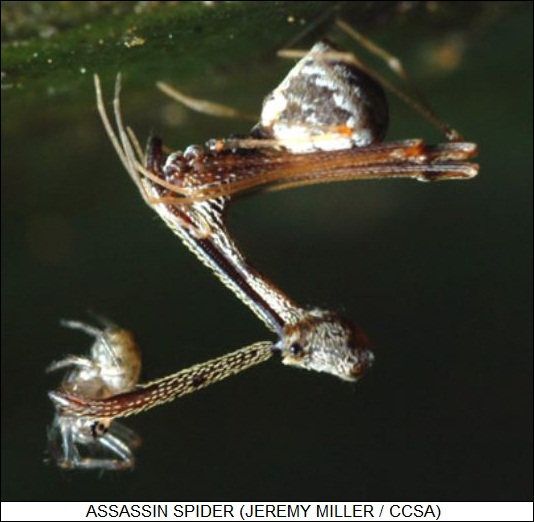
Incidentally, while spiders such as orb weavers may seem mundane compared to these exotic species, they can have interesting adaptations of their own. Recent research shows that the golden orb weaver spider of tropical Asia generates web silk with an "ant repellent" chemical. The repellent prevents ants from raiding spider webs for prey caught in the web, and possibly even attacking the spiders themselves.
* A second item from WIRED.com concerned the "harvestman" or "daddy longlegs", another member of the class of arachnids, along with scorpions and the superficially similar spiders. The harvestman is delicate in structure and so doesn't fossilize well; not many specimens have been found. However, a team led by researchers at Imperial College London (ICL) has now reconstructed two fossil daddy longlegs using a relatively new 3D scanning technique.
The fossils date back to the Carboniferous era, 300 million years ago, well before the age of dinosaurs. Traditionally, paleontologists have had to carefully remove layers from a fossil to reveal the organism embedded in stone, a technique that doesn't work at all well with little delicate bugs. To obtain detailed models of the two harvestman fossils, they used "computerized tomography (CT)", taking thousands of images of each fossil over a range of angles, and then digitally determining the shape of the organism encased within, the same approach having been discussed here in 2009.
Paleontologists have judged the harvestman a "primitive" species, not in that it is "cruder" than other arachnids -- such a distinction is meaningless in evolutionary terms -- but in that it's been around in much the same form for a very long time, being a form that works so well that it's never been under much pressure to visibly change. The two fossils analyzed bear this assumption out. Says one of the ICL researchers: "It is absolutely remarkable how little harvestmen have changed in appearance since before the dinosaurs. If you went out into the garden and found one of these creatures today it would be like holding a little bit of prehistory in your hands."
COMMENT ON ARTICLE* ORION IN DEVELOPMENT: While the Bush II Administration's ambitious but inadequately-funded Constellation space program turned out to be a nonstarter, as discussed in an article from AVIATION WEEK ("Deep Space" by Frank Morring JR, 9 January 2012), Constellation's Orion crewed space capsule remains on track.
The US National Aeronautics & Space Administration (NASA) is taking a deliberate and cautious approach to developing the spacecraft, hoping to avoid spiraling cost growth. The agency has already spent more than $5 billion USD on Orion development and doesn't want costs to keep piling up. Right now, the program is on track, for the first orbital launch in 2014, with a Delta IV Heavy booster sending an unmanned Orion on two orbits around the Earth. It will be followed by a suborbital "ascent-abort" flight to test the abort system, with the spacecraft launched by a surplus Peacekeeper ICBM. A crewed flight is not expected until 2021.
As originally conceived, Orion -- in the present day more formally named the "Multi-Person Crew Vehicle (MPCV)" -- was to be a six-person space station ferry vehicle and a four-person deep-space vehicle. Under the current vision, space station ferry will be handled by a commercially-obtained vehicle such as the SpaceX Dragon capsule, and so the Orion is now strictly defined as a four-person deep space vehicle.

The basic configuration of Orion hasn't actually changed much from the earlier Constellation design, the spacecraft very much resembling a scaled-up version of the 1960s Apollo spacecraft, with a conical "command module" riding on an expendable "service module". On takeoff, as with Apollo, the Orion command module will be topped by a launch-abort tower that will fly the crew to safety in case of a launch failure -- lack of a launch-escape system being seen as one of the fundamental flaws of the space shuttle. There are clear differences as well:
The agency is in discussion with foreign partners such as the European Space Agency (ESA) for collaboration on service module development, possibly leveraging off technology developed by the ESA for the Automated Transfer Vehicle (ATV) cargo capsule now being used to support European space station activities. It is known now that the service module will be fitted with a main engine derived from the space shuttle orbital maneuvering system (OMS), with a thrust of 26.7 kN (2,720 kgp / 6,000 lbf). The Orion's thruster system will be powerful enough to act as an emergency propulsion backup in case of a main engine failure.

Right now, projected missions include a visit to the "L2" Earth-Moon Lagrange point, beyond the far side of the Moon; a visit to an asteroid; or a trip to Phobos, one of the two moons of Mars. A nominal L2 mission would last 35 days, with the crew keeping busy operating surface rovers and probes, or planting a low-frequency radio telescope on the lunar farside, where it would be deaf to Earthly radio noise. Possible asteroid missions have been outlined, with a trip to Asteroid 2008 EA9 lasting 195 days, or a trip to Asteroid 2000 SG334 lasting 450 days. A Phobos mission would last 900 days, with the crew sampling the moon extensively and operating rovers on the Martian surface.
* In related news, NASA has been mandated to develop a new heavy-lift booster, the "Space Launch System (SLS)", at a time when the agency's funding is under pressure. Meeting schedule for the first launch in 2017 -- to be followed by a crewed Moon orbital flight with the Orion capsule in 2021 -- is leading to some necessary compromises.
The initial SLS configuration will feature a core stage powered by liquid oxygen / liquid hydrogen, using surplus Space Shuttle Main Engines (SSMEs) -- though the plan over the longer term is to use the RS-25E SSME, cost-reduced for expendable operation. The core stage will be augmented by twin solid-rocket boosters (SRBs) derived from the shuttle SRBs, though with five segments instead of the original four. The upper stage is to be powered by the "J-2X", a modernized version of the J-2 engine used on the Saturn 5 booster that sent Apollo astronauts to the Moon, but development of the J-2X is stretching out.

NASA now intends to obtain an "interim upper stage" for the 2017 and 2021 flights, using an off-the-shelf rocket engine. NASA's requirements state the interim upper stage must be hydrogen-fueled, rated for human launches, and capable of at least three ignitions. The upper stage system must be delivered to the Kennedy Space Center by the end of 2016 to support the first SLS mission. Given the limited production buy, rocket builders have not demonstrated great interest in the NASA request -- so what happens next is anyone's guess.
COMMENT ON ARTICLE* NATURAL GAS REVOLUTION (1): The boom in the natural gas business in the USA was discussed here in 2010. An article from THE ECONOMIST ("Coming Soon To A Terminal Near You", 6 August 2011) drew a picture of the global impact of the natural gas rush.
The enthusiasm for natural gas is evident in China, where six huge liquefied natural gas (LNG) terminals are now being built. By the end of 2015, they will support a doubling of China's imports of LNG. At the other end of the country, a pipeline from Turkmenistan also hauls in gas, while in the interior geologists and engineers are looking over the land for new wells to boost China's rapidly-growing local production of gas. China will consume 260 billion cubic meters (260 BCM) of gas a year by 2015, according to the country's 12th five-year plan, more than triple the 81 BCM used in 2008.
Ironically, China's natural-gas business owes less to the planning of its own government than by a piece of legislation passed decades ago in the USA: America's Natural Gas Policy Act of 1978. The act deregulated the natural-gas market, encouraging companies to take chances with new drilling technologies. Geologists had long known there was gas trapped in America's shale beds, but attempting to exploit it seemed economically risky. From 1978, the revised economics made the risks seem worthwhile. Independent companies investigated advanced exploitation techniques such as horizontal drilling and particularly "fracking", in which high-pressure fluids are used to crack open the otherwise impermeable shales. It paid off: shale now provides 23% of America's natural gas, compared to 4% in 2005.
The new shale gas industry not only changed America's gas markets, it had a global follow-on effect -- not just because of exports of American gas, but also because foreign producers that once exported LNG to the USA now had to find new markets, and of course because shale gas can be exploited elsewhere. In fact, thanks to the competition in the market and the widespread availability of shale gas, no shale gas producers are able to exert the kind of political leverage with gas as the big oil producing countries have with their product.
Few saw the shale-gas revolution coming. In 2003, the US National Petroleum Council estimated that the continent of North America might have 1.1 trillion cubic meters (TCM) of recoverable shale gas. Now, America's Advanced Resources International estimates there might be 50 times as much. There appears to be plenty elsewhere, with the US Energy Information Administration producing a report that looked at 48 shale-gas basins in 32 countries, estimating the total deposits as 190 TCM -- and that's excluding possible finds in the former Soviet Union and the Middle East, where nobody has much interest in shale gas for the time being because they have huge reserves of conventional gas.
Estimates for total gas resources are likely to increase with improvements in geological analysis and extraction technologies. The game doesn't end with shale gas, either, there being other possible sources for gas. There's "tight gas" in sandstones, as well as coal-bed methane, a traditional hazard in coal mines. Farther out, there's the possibility of exploiting gas frozen into hydrates on the Earth's oceanic continental shelves, which might provide more than 1,000 TCM -- if an economical way can be found to extract it.

The International Energy Agency (IEA) has released a survey, the "World Energy Outlook", including a section titled "Golden Age Of Gas". The IEA's vision suggests annual world production rising by 1.8 TCM between now and 2035, when it will reach 5.1 TCM, much of it obtained from unconventional sources. Trade in gas between the world's major regions will double, with coal use beginning to decline from late in the current decade -- to fall behind gas in 2030, when gas will provide a quarter of the world's energy. [TO BE CONTINUED]
NEXT | COMMENT ON ARTICLE* FUTURE FLIGHT (8): To the extent that people are thinking of what follows the current generation of fighters and bombers, the general vision is that unmanned systems will increasingly predominate, including missiles and drones. There's energetic work in drones these days at all ranges of scales, from hand-launched infantry drones, to battlefield drones like the Predator, to long range surveillance drones and "unmanned combat aerial vehicles (UCAV)" -- attack drones, stereotypically stealthy flying wings of various configurations, such as the US Navy X-47B. Even the smaller drones are carrying armament these days, with a comparable ferment in the development of little guided munitions in the range of roughly 5 to 25 kilograms (11 to 55 pounds).
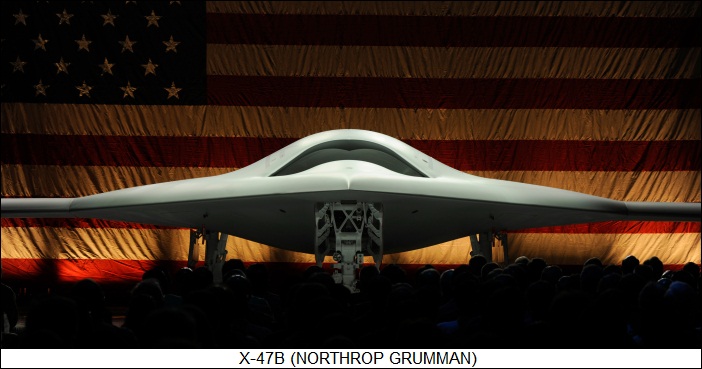
The problem with drones is that, traditionally, they're not as smart as piloted aircraft. Drones are getting smarter all the time of course, but will they still be able to do the job in combat? One hedge on this bet is "optionally piloted" combat aircraft, for example a bomber that can either carry a crew or fly on its own. If an aircraft is of sufficient size to comfortably haul a crew, having the option to pack a crew enhances operational flexibility, and it also frees the need for a ground station to control a mission.
The fact that there are scores of relatively small piston or turboprop-powered drones operating in combat with the latest little smart munitions also leads to the question of why air forces aren't operating more small piloted turboprop-powered attack aircraft armed with the same little smart munitions. They're not inherently more expensive than a drone, and indeed they don't need an elaborate ground-control station. If a pilot is smarter than a drone, why not?
That leads to the bigger question of whether high-performance fighters are really needed in an era of dirty little wars and advanced guided munitions. Could we imagine the military operating fuel-efficient hybrid light attack aircraft, armed with the latest munitions and fitted with leading-edge networking and sensors? It would certainly be much cheaper to operate small hybrids and reserve high-performance fighters for when they're needed.
Air Force brass are not fond of this idea, worrying about being saddled with a fleet of low-performance aircraft in a confrontation against an adversary armed with the latest generation of fighters. However, there is a faction that wonders just how realistic the idea of an air-combat "peer adversary" is really going to be in the future. It's not just the staggering growth in expense of each new generation of fighters, suggesting sixth-generation fighters made of unobtainium; it's also the fact that anti-aircraft defenses are continually improving. In a generation pilots may not need to worry about superior fighters so much as they will need to worry about very smart missiles with very long reach that are very hard to escape.
In such an environment, high-performance piloted combat aircraft may be an anachronism, with intensive air combat reduced to a matter of "their missiles versus our missiles" -- or at the very least, their missiles versus our relatively small and stealthy drones that are hard to spot and hit, or high-altitude drone platforms operating as long-range sensor or missile platforms.
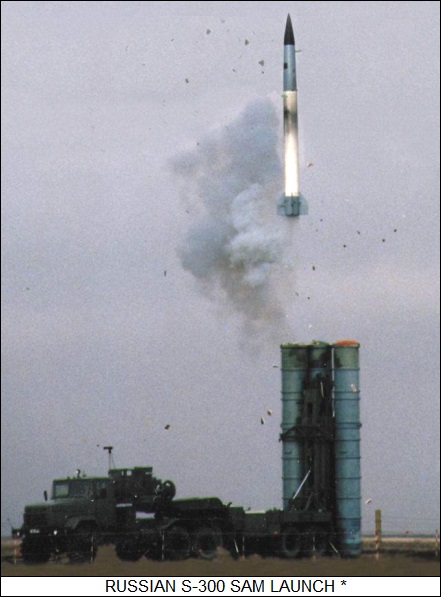
Assuming, with good reason, that the era of dirty little wars is far from over, that would still leave a place for piloted light strike aircraft in fights against insurgents lacking serious air defenses. Possibly such are the future for piloted, or optionally-piloted, combat aircraft, and the fifth-generation fighters on which so much money and effort have been expended are the end of the road; there will be no sixth-generation fighters. Or if there are, they will be robots. [TO BE CONTINUED]
START | PREV | NEXT | COMMENT ON ARTICLE* GIMMICKS & GADGETS: As reported by a release from the US Naval Research Laboratory (NRL), researchers there are conducting studies under a US National Aeronautics & Space Administration (NASA) grant on planetary "mini-rovers" that would weigh about a kilogram and would be powered by a "microbial fuel cell (MFC)". An MFC is built around bacteria; that sounds exotic, but the idea has been validated. Compared to lithium cells, MFCs potentially have long lifetime and high energy density.
The NRL work is focused on turning the MFC into a more practical system. The active element of the NRL MFC would be a pure culture of an anaerobic bacterium, specifically Geobacter sulfurreducens. The MFC wouldn't provide a lot of power at any one time -- enough to keep rover electronics systems going while charging up a capacitor to provide burst power to a hopping system.
The concept of an MFC has been around for about a century, but it has only recently become of practical interest. Traditionally, a fuel cell consists of two electrodes separated by a membrane; a fuel, stereotypically hydrogen though hydrocarbons are often used as well, is provided to the anode, where it is catalytically broken down. The electrons obtained from the breakdown are sent over an external circuit to power an electrical load, while the protons that are left over migrate through a proton-exchange membrane towards the cathode. When a hydrocarbon fuel is used, the anode produces CO2 as a waste product. The cathode draws the electricity sent through the load, completing the electrical circuit, using the electrons and the protons along with oxygen to produce water as a waste product.
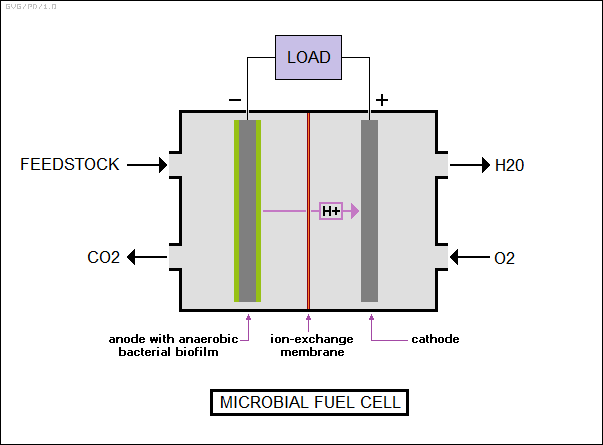
In an MFC, the bacteria act as the "catalyst" for the anode, breaking down whatever fuel they can digest. The cathode still requires catalysts to transform oxygen and protons into water. The feedstock in lab items is often glucose, but there's work on MFCs driven by waste water, to to produce not only electricity but also clean water. It's not enough power to do more than run the facility, but the idea is still slick.
* Efforts to set up municipal wi-fi networks have had limited success, with pockets of public wi-fi in many large cities -- but so far, wi-fi hasn't become remotely as prevalent as street lighting. It's moving along, however. Malaysia's capital, Kuala Lumpur, has now mandated that come spring all restaurants, cafes, bars, pubs, and clubs larger than 120 square meters will need to provide wireless Internet access for free or "for a reasonable fee".
The city is currently conducting a survey to figure out just how many establishments are already wi-fi enabled. Oddly, while the city had been helping fund wi-fi connectivity, it's given up doing so, obviously feeling that the effort would be better performed by the public under the guidance of a government mandate. High-handed? Maybe so, but it does seem like municipal wi-fi is an idea whose time is coming. Cities make sure their streets are illuminated at night and citizens have come to expect it. A pervasive baseline wireless communications network would seem at least if not more useful than a streetlight system, giving city workers the ability to interact with all the kit required to keep a city going, while giving citizens a basic communications capability.
* Zookeepers at the Milwaukee County Zoo have found their orangutans are fascinated by iPad tablets. The apes respond to them as do small children, enjoying moving colors and videos, particularly of other orangutans. The keepers are now considering using cameras along with the iPads so the orangutans can watch each other. The orangutans only use the iPads under very close supervision, however -- left to themselves, the apes would break them immediately. Over the long term, the zookeepers would like to set up a fixed and ruggedized installation.
It might be interesting to set up a Kinect gesture recognition system to give the orangutans more control input, and see just how sophisticated they could become as users; we might be surprised at what the apes can do. Orangutans are said to be more technically savvy than other apes. According to tales that are possibly even true, if a chimp is given a screwdriver, it will use it to punch holes in things, while an orangutan will break out of its cage.
COMMENT ON ARTICLE* ALGAE BIOFUEL COMEBACK: As discussed in an article from AAAS SCIENCE ("Algae's Second Try" by Robert F. Service, 2 September 2011), in the wake of the energy crisis of the 1970s, the US National Renewable Energy Laboratory (NREL) in Golden, Colorado, extensively investigated the use of algae to produce biofuels. The effort, mentioned here in 2010, went nowhere, finally getting the axe in the early 1990s.
Now work on algae biofuels is booming, with private investment leading the way. Why the renewed interest? Two words: synthetic biology. During the earlier investigations researchers had little ability to usefully manipulate the genomes of algae. Today, researchers have access to ever-growing genetic toolkits that will allow them to improve the efficiency of algae at producing fuels.

Algae is interesting because it is, potentially, a very efficient producer of plant oils. The majority of biofuel production is of ethanol produced from fermentation of corn or sugar; ethanol has a tendency to rot fittings, has relatively low energy density compared to gasoline, and isn't particularly well suited to powering heavy vehicles. Plant oils can easily be converted into diesel-type fuels that can be run on any vehicle that burns diesel, have higher energy density than gasoline, and of course are well-suited to use on heavy equipment.
The problem is that ordinary sources of plant oils, such as oil palms and rapeseed, aren't very efficient, being able to produce no more than about 6,000 liters of fuel per hectare per year. In principle, algae should be able to produce an order of magnitude more fuel per hectare per year, making much more efficient use of land. Algae can grow in brackish water, salt water, even waste water, and algae can be produced on land not otherwise suited for farming, meaning it doesn't compete directly with food production.
So why don't we have an algae biofuel utopia just yet? Because the efficiency of algae has traditionally been only a potential. In the past, the amount of algae in a pond could never grow above about a thousandth of the volume of the pond. There was the problem of obtaining the water, as well as extracting the algae from the water and then extracting the oil from the algae to produce fuel. At best, algae biodiesel is about twice as expensive as ordinary diesel.
There are two approaches to growing algae. One is to grow it in shallow open-air ponds, but as mentioned they can't grow to high concentrations, and the algae is also threatened by pathogens and competitors that blow in from the air. The other approach is to use bioreactors, which are closed chambers for growing algae. Bioreactors are much more productive than open-air ponds, but they're also much more expensive.
Synthetic biology can help out with both approaches. Until recently, the maximum amount of oil produced by algae was no more than 40% of plant mass, but now, thanks to the ability to perform a range of genetic manipulations simultaneously, algae researchers are looking at ratios of 80% or better. There's also work underway to make algae more efficient at photosynthesis. One of the peculiarities of algae is that it absorbs four times as much light as it actually needs, apparently as an evolutionary adaptation to block competitors in its immediate environment. Researchers at the Donald Danforth Plant Science Center in Saint Louis, Missouri, have been able to tweak algae so they don't hog more sunlight than they actually need.
The Danforth team is also improving algae by hybridizing its genome with human DNA. Algae has an enzyme named carbonic anhydrase II (CA II) that it uses in carbon dioxide processing; humans cells also produce CA II, and the human variant is much more efficient than the natural algae variant. Splicing the human CA II coding into the algae genome roughly doubled its photosynthetic efficiency.
Other organizations are less forthcoming about what they're doing to algae, though there are players who claim they should be able to produce biodiesel at costs competitive with ordinary diesel. A British research group is also investigating the production of biodiesel using photosynthetic bacteria and is currently operating a pilot plant in Texas. All in all, the general outlook in the industry is optimistic, with researchers believing they have a good shot at achieving the dream of cost-effective, large-scale production of biofuels.
* As a footnote on algae biofuels, AAAS SCIENCE reports ("Engineering Superbugs Boost Hopes Of Turning Seaweed Into Fuels" by Erik Stokstad, 20 January 2012) that researchers have developed a genetically modified strain of the well-known Escherichia coli bacterium to help process seaweed into biofuels. Seaweed would seem like an excellent feedstock for biofuels, requiring neither cropland nor fresh water to grow, but it has a problem: about a third of the sugars in seaweed are in the form of "alginate", a complex polymer that is hard to convert into biofuel. Now a team under Yasuo Yoshikuni of Bio Architecture Lab (BAL) in Berkeley, California, has come up with a GM strain of E. coli that will break down and ferment all significant sugars in seaweed into ethanol. There remains the question of how practical biofuel from seaweed really is, with one study suggesting that to replace 1% of America's fuel requirements would require growing seaweed over 11,000 square kilometers.
* As another footnote, as noted by an article from THE ECONOMIST ("Brazilian Brew", 7 January 2012), biofuels have generally been a disappointment so far, proving expensive and less "green" than they are promoted as being. The most infamous case is American corn ethanol, with pessimists saying that it takes more energy to produce it than it delivers. That's an extreme view, but even optimists admit the ratio of "energy out" to "energy in" is low. Given that traditionally high import duties were placed on cheaper imported ethanol, US government support for corn ethanol was hard to tell from a crop subsidy.
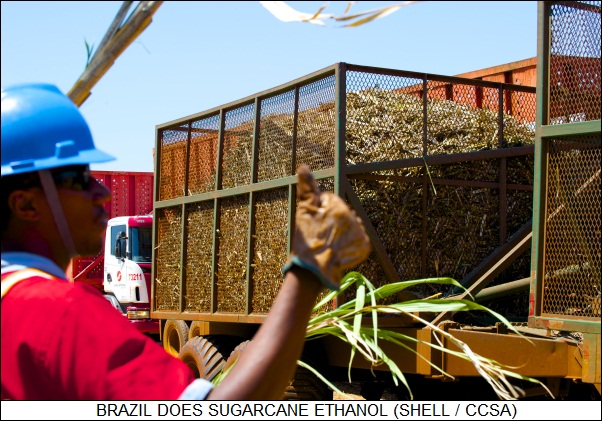
That's gradually changing. The US Energy Independence Act of 2007 set ambitious targets for American biofuel production by 2022, but specified that 60% of it would not be produced from corn. More significantly, maintaining the tacit corn subsidy was expensive in a time of tight government spending, and was enough to finally overwhelm farm state lobbying to maintain it. At the end of 2011 tax credits for American corn ethanol and import duties on foreign ethanol finally lapsed. The import duties were targeted at Brazil, which actually has made a go of biofuels, building up a huge industrial system to produce ethanol from sugarcane, a much more efficient feedstock than corn. The duties had been a long-standing irritation to Brazilians, with Marcos Jank, head of Brazil sugarcane-grower's trade association, proclaiming: "We've been waiting for this news for 30 years!"
Brazil's sugarcane ethanol business had gone soft recently, with plants not operating at capacity, but with the export market opened up, producers are expected to invest to expand capacity. Construction of new plant facilities will be accompanied by efforts to improve efficiency, for example using production waste for electricity generation and cattle feed. For all the sniping at biofuels, they seem like a very good idea, and Brazil has demonstrated that it can be done. It's just going to require sorting through a lot of options to figure out which ones can be made to work -- and making them work right is not necessarily going to be easy.
COMMENT ON ARTICLE* INDIA ID REVISITED: India's "Unique Identity (UID)" scheme to provide ID cards to Indians was described here in 2009. As reported by an article from THE ECONOMIST ("India's UID Scheme", 14 January 2012), it's moving right along, with over 200 million Indians now signed up. Over 400 million, a third of Indians, are projected to be signed up by the end of 2012. That's particularly impressive, since the current Indian government has not otherwise been marked by any efficiency in getting things done.

UID was driven by the fact that vast numbers of poor Indians cannot prove who they are -- no passport, no driver's license, no valid documentation at all. They are, in terms of a modern economy, nonpersons, unable to open bank accounts or take out loans. The government tries to help with welfare, but it is heavily looted by intermediaries involved with the system.
The idea behind UID was to be able to ensure that the government could electronically get payments to every Indian, with Indians able to validate that they had got the payment through biometric markers, such as an iris scan. Nandan Nilekani, a tycoon now working in public service to run the UID effort, says the exercise is "essentially about better public services".
Any resident of India, not just a citizen, can request a UID. The scheme is being driven by India's central and state governments, working with commercial partners, particularly technology firms hired to capture and process individuals' data. Nobody was expecting the Indian government, noted for its factionalism and ineptitude when not being pilloried for outright corruption, would be at all efficient in implementing UID, but it's been going well. Large numbers of enrollment centers were set up, each processing dozens of Indians a day. Wipro and the other agent companies performing the enrollments are only paid about half a dollar per signup, which means getting signups done in less than 12 minutes to turn a profit. Young and literate Indians are easy to process; old, rural, and illiterate Indians are not so easy. The companies have proven flexible in meeting the challenge.
However, as the project continues to build momentum, political problems are accumulating in pace. Allocated funding is running out, though the government's enthusiasm is such that more rupees are certain to be provided. The effort is also inevitably becoming more expensive as its scope increases, though that's not such an issue, one senior economic adviser saying that by "plugging leakages" -- from waste and fraud -- UID will easily pay for itself.
There has been resistance from the home minister, Palaniappan Chidambaram, who has expressed doubts about UID on a national security basis, but since UID has the backing of Prime Minister Manmohan Singh, the home minister's complaints carry little weight. However, Singh will not find it so easy to deal with the complaints of the political opposition, mostly the Bharatiya Janata Party, with the opposition in Parliament presenting an extended report detailing the problems with UID and saying it should be halted. To be sure, the mindset of the report was that "no stone be left unthrown", but it did score some legitimate hits.
The report indicated unhappiness that UID was being established by executive order, not a parliamentary bill, and complained about the cost, which is admittedly substantial. Again, however, UID seems very likely to pay for itself, particularly as more Indians obtain bank accounts hooked up to UID to permit direct and traceable transfers of funds, bypassing intermediaries where the money has an unfortunate tendency to disappear. State governments are already seeing benefits.
The angriest protests against UID have been from activists and development economists, who worry that UID data is not secure, and that the safeguards on individual privacy are inadequate. They particularly worry that the voluntary program will eventually be made compulsory. Some also say that direct cash transfers, while efficient in a financial sense, run the risk of, say, being spent on booze instead of food -- and in the most isolated villages there's no food or fuel markets where the money can be spent anyway.
Those are perfectly legitimate concerns; the idea of sophisticated hackers, possibly backed by foreign intelligence services, breaking into India's UID database is a definite nightmare, and laws need to be established to ensure to prevent the government from using UID for unwanted intrusion into the lives of citizens. As for what happens to direct cash transfers, that's going to have to be monitored. However, UID is hardly an exercise in trying to fix something that isn't broken; the current system is badly broken, and most realize that UID is going to be an improvement.
COMMENT ON ARTICLE* DNA NANOTECH COMING OF AGE (2): There are still critics who don't take DNA nanotech seriously, but advocates say they now have the capability to perform real work with their tools. Ned Seeman, having invented DNA nanotech to help with protein crystallography, is now attempting to use the tech to that end. In 1999, Seeman and a group of collaborators reported that they had manage to link a set of DNA triangles into a 3D lattice with rhombohedral voids, and inspect the assembly with X-ray crystallography. Seeman was excited about the exercise, saying: "I know where every atom is." The structure still doesn't have fine enough resolution to be useful in protein analysis, but the group is working on that. Ultimately, the idea is to perform X-ray crystallography on a DNA lattice with proteins trapped in the voids, with the presence of the lattice subtracted by analysis software.
While X-ray crystallography applications are a (near) future, William Shih -- a DNA nanotech researcher at Harvard Medical School (HMS) in Boston -- has already used DNA nanotech to help analyze proteins using nuclear magnetic resonance (NMR) spectroscopy. NMR can map out the structures of proteins using the magnetic signatures of the atoms in the protein molecule. Traditionally, NMR spectroscopy hasn't worked with very elaborate molecules since it's been impossible to sort out the clutter. Work in the late 1990s, however, showed that constraining protein molecules in a solution with liquid crystal molecules provided hints that helped unravel the structures of big molecules.
One of the problems with the liquid-crystal approach is that some proteins can only be dissolved into a solution with the help of a detergent, which breaks up liquid crystals. In 2007, Shih and his colleagues tried using DNA nanotubes instead, which aren't affected by detergents, and reported success in analyzing a protein that had previously defied inspection. At Oxford, Turberfield's group similarly reported success in using DNA nanotech to constrain proteins for analysis by electron microscopy. Other researchers are discovering a widening range of possible uses: Japanese researchers, for example, have used DNA nanotech to examine catalytic reactions of proteins in step by step detail. Seeman comments: "It's a chemist's dream to watch individual reactions happen."
* Precision lab analysis tools are all very nice, but some researchers have much more ambitious ideas about what can be done with DNA nanotech. Shawn Douglas, a graduate researcher in the genetics lab of George Church at HMS, wants to build a "DNA nanorobot" that will seek out and destroy cancer cells. The nanorobot actually looks like a hollow cylinder about 60 nanometers long and 35 nanometers across. He fabricated it using DNA origami and stapled it up using DNA strands known as "aptamers", with Douglas synthesizing his aptamers so they specifically bound to molecular markers on cancer cells.
Douglas then loaded the cylinder with fluorescent immune-system proteins that would bind to cancer cells and command them to "commit suicide", a process known as "apotosis". He performed a test on cancer cells in vitro and killed off 40% of them. The nanorobots aren't remotely ready for real-world use, but the exercise has definitely impressed the community. Other researchers have gone even farther in their thinking, working towards DNA nanomachines known as "walkers" that can collect molecular components and assemble them, possibly assisted by implementation of sequencing algorithms using DNA computing capabilities. DNA nanotech may still seem somewhat toylike; but believe that given its potential, they'll have the last laugh before too long.

* In a footnote to this series, researchers at Northwestern University in Chicago have been taking a hybrid approach to DNA nanotech, using arrangements of DNA-coated nanoparticles and DNA strands to create a wide range of crystal configuration -- obtained by varying the nanoparticle types and diameters, as well as DNA segment lengths, using six design rules. The researchers have been able to design 41 different crystal arrangements, but of course the possible number of crystal configurations is unbounded. [END OF SERIES]
PREV | COMMENT ON ARTICLE* FUTURE FLIGHT (7): This series has focused on future civil aviation, which leaves open the question of the future of military aviation. To be sure, if highly efficient civilian airliners are developed, the military is certain to leverage off them for cargolifters, patrol aircraft, and the like -- but what about high-performance jet fighters and bombers?
As discussed in the 23 January 2012 issue of AVIATION WEEK, which provided a survey of aerospace for 2012, there's not as much of a vision of the future there. The effort to develop and field the latest "fifth generation" of jet fighters, such as the Lockheed Martin F-35 Joint Strike Fighter, has proven so protracted and financially exhausting -- particularly given the current environment of tight funding -- that nobody is seriously working on a "sixth generation" fighter just yet.
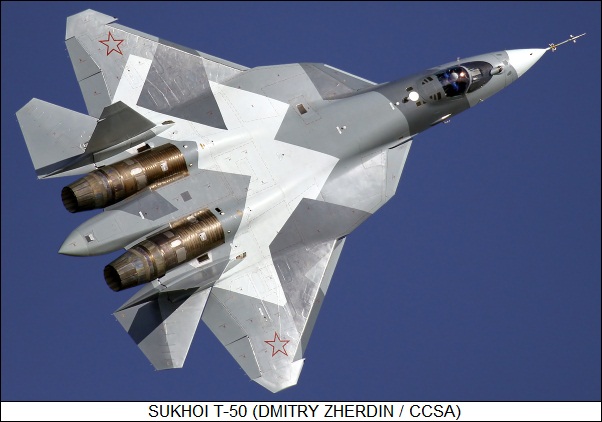
Indeed, the motive for even considering a sixth-generation fighter is weak. The global race to fifth-generation fighters began in the late 1980s, predicated on the belief that the Soviets were going to field such advanced combat aircraft. The Soviet Union then collapsed, eliminating much of the rationale behind the effort. The successor Russian state hasn't even fielded their fifth-generation fighter, the Sukhoi T-50, just yet, while the most advanced Chinese fighter, the J-20, is even further from operational status. The potential threats that the West developed fifth-generation fighters to deal with ended up behind the learning curve.
The US Air Force (USAF) planned a massive fleet of Lockheed Martin F-22 Raptor fifth-generation fighters, but the Raptor build proved far smaller than expected, and production of the Raptor has now been ended. It was simply too expensive to make further expansion of the inventory worthwhile. Work on a next generation of bombers is similarly going nowhere particularly quickly. The USAF's mainstays remain the ancient but flexible Boeing B-52 along with the Rockwell B-1, itself hardly a new machine, with the handful of fantastically expensive Northrop Grumman B-2 stealth bombers reserved for specialized missions. The USAF does have a "Long-Range Strike Bomber (LSRB)" program in progress at the present time, but for the moment it's no more than an investigation; the goal is for a next-generation piloted strike platform to be available by the mid-2020s, this machine being also capable of surveillance and electronic warfare missions, and absolutely not as expensive as the B-2.
In the current economic climate, there's considerable work on keeping older combat aircraft in service and production -- with aircraft dating back to the 1970s, such as the F-15 and F-16, still rolling off the production lines, updated with the latest kit, and aircraft already in service being retrofitted with new gear. The US Navy's current first-line fighter is the Boeing F/A-18E/F Super Hornet, a growth version of the long-serving Hornet fighter. Everything old is new again.

The older fighters were never all that deficient anyway. There was a massive jump in aircraft performance and capability from the late 1930s into the early 1960s, but then diminishing returns set in. For all the expense of the fifth-generation fighters, to the extent that they have an edge, it's hard to say how much it matters. The US Navy's Super Hornet tends to be derided as a stodgy design, but it does the job, being able to carry a heavy warload over relatively long range, useful in air combat, attack, reconnaissance, electronic countermeasures, and even tanker roles. The Navy is looking forward to the F-35, but it is unclear that it will be a complete replacement for the Super Hornet.
This is not to say that the military isn't interested in futures, with work continuing on improved avionics systems, including "active array" radars, countermeasures, and networking -- networking being a particularly big thing, allowing combat aircraft to interact with each other or with ground and sea platforms, forming a "system of weapon systems", the whole being much greater than the sum of the parts. There's considerable work on new guided munitions, including small smart weapons, missiles with increased range and more sophisticated seekers, and multimode weapons capable of engaging a wide range of targets -- a single missile that can engage ground or air targets, for example, making an attack aircraft more flexible and simpler to "bomb up". An older fighter with advanced avionics and weapons remains a force to be reckoned with.
There's also considerable work on new engine development -- for example the US Air Force's "Adaptive Versatile Engine Technology (ADVENT)" program, which envisions a "variable cycle" fighter / bomber engine that operates along turbofan lines for cruise while acting as an afterburning turbojet in combat. Rolls-Royce and General Electric are working on demonstrators, the target being an engine that's 25% more fuel-efficient by 2015. The US Navy is leveraging off ADVENT for their own "Variable Cycle Advanced Technology (VCAT)" effort, intended to produce an engine suitable for carrier service. 25% fuel economy improvement seems like a modest advance compared to the economies potentially offered by hybrid airframes, but such are not suited to high-performance combat operations.
In addition, the military is investigating new engine technology for other flight platforms, for example the "Highly Efficient Embedded Turbine Engine (HEETE)" effort, which is working to develop a midsized high-bypass turbofan engine with 25% greater fuel economy that can be embedded into a stealthy airframe, instead of hung on a pylon to announce its presence to every radar from reflections off the spinning fan blades.
The US Army is also investigating an "Advanced Affordable Turbine Engine (AATE), a turboshaft for small and medium rotorcraft with improved fuel economy, as well as purchase and maintenance costs. The "Future Affordable Turbine Engine (FATE)" program is similarly working towards a next-generation turboshaft for heavy helicopters. In the meantime the military, as well as the airlines, are working to deal with worries about future access to fuel supplies by investigating biofuels, though so far nothing's turned up that can do more than stretch conventional fuel supplies. [TO BE CONTINUED]
START | PREV | NEXT | COMMENT ON ARTICLE* ANOTHER MONTH: An article from BBC.com ("The Afterlife Of Implants" by Clark Boyd & Rob Hugh-Jones, 20 February 2012) discussed a business that was definitely out of the box: recycling surgical implants from the deceased.
Welcome to Orthometals in the city of Zwolle in the Netherlands, a firm that recycles metal implants from cremated human bodies -- everything from steel pins to titanium hips and cobalt-chrome knees. Ruud Verberne, co-founder of OrthoMetals, says that the usual response when he tells people what he does for a living is: "That's a bit strange."
Verberne had been working in aluminum recycling when, in 1987, he met Jan Gabriels, an orthopedic surgeon, who asked him what happened to the metal implants Gabriels had been installing in patients who later died. Verberne checked around and found out that they were simply tossed, usually buried. A decade later, Verberne and Gabriels founded Orthometals, and now they recycle more than 250 tonnes of high-value metals a year. The recycling value of the metals is maybe about 2% of the original cost of the implant, but even at that, 250 tonnes of surgical-class metals brings in the equivalent of about $4 million USD a year.
Crematoriums simply hand the implants over to OrthoMetals, where they are sorted out by metal type -- using magnets to the extent that works, by hand otherwise -- and melted down for sale to metals brokers, the metals then being used in any sort of product that can use them. The crematoriums then get up to 75% of the proceeds. Verbenne says that about half a dozen other firms have popped up to recycle surgical implants, most of these companies being in the USA, but adds that OrthoMetals was the pioneer.
Ethical concerns over the use of implants from the dead don't seem to be much of a problem, mostly because the implants weren't a natural part of the body of the deceased in the first place, and unlike a ring or other decorative item, they have no sentimental value. However, crematories are generally careful to tell the next of kin what's going to happen to the implants. Few raise objections, the next of kin unusually not thinking they need to hang on to a used prosthetic hip joint.
* I mentioned here two months back that when I go to a McDonald's and they ask me for a name, I would always give them a different name. That got a little tiresome, so now I just answer: "Harvey."
They swallow that with no problem, but I'm waiting for the day when somebody asks: "Your name's Harvey, right?"
"Oh no, Harvey's my invisible friend. Since you can't see him, I have to order for him." I get the feeling that a lot of people below a certain age won't get that gag. [ED: McD's eventually gave up on asking for names. I think too many people were using it as a gag.]

* Readers may have noticed the quantity of illustrations in the blog has ramped up considerably. Nowdays I feel disappointed if I don't have at least one illustration for an article, though sometimes I have to get a bit imaginative to find or cook up an illustration that works.
Finding and preparing illustrations has become something of a project in itself, and I had to figure out a new numbering system for the images. Up until now I just numbered the illustration in an article for the date of the entry, but I started to overflow the available days in a month, so I had to break free of dates and make more efficient use of two digits. No more capacity problem, but keeping the illustrations and the postings coordinated is a bit trickier now.
COMMENT ON ARTICLE